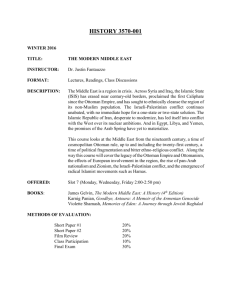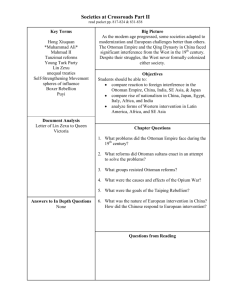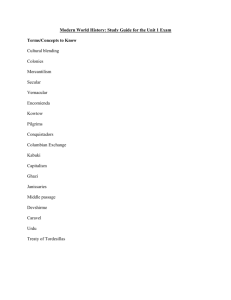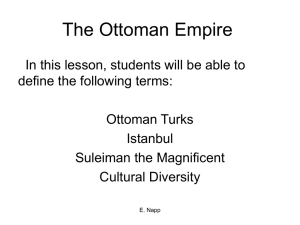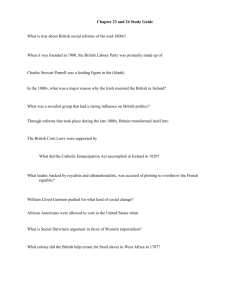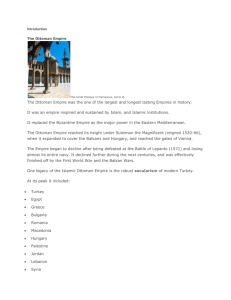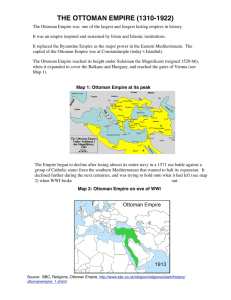The Ottoman Empire and Meiji Japan
advertisement
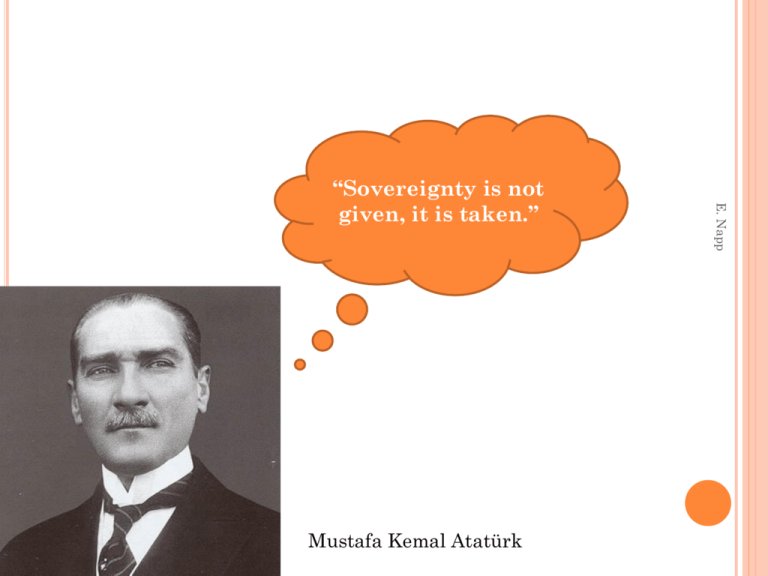
Mustafa Kemal Atatürk E. Napp “Sovereignty is not given, it is taken.” Like China, the Islamic world felt little need to learn from the “infidels” of the West until it collided with an expanding Europe Unlike China, Islamic civilization had been a near neighbor to Europe for 1,000 years The Ottoman Empire had governed parts of the Balkans and posed a clear military and religious threat to Europe in the sixteenth and seventeenth centuries But if its encounter with the West was less abrupt than that of China, it was no less consequential Neither the Ottoman Empire nor China fell under direct colonial rule, but both were much diminished by this changing balance of power E. Napp E. Napp In 1750, the Ottoman Empire was still the central political fixture of a widespread Islamic world. From its Turkish heartland in Anatolia, it ruled over much of the Arab world, from which Islam had come. It protected pilgrims on their way to Mecca, governed Egypt and coastal North Africa, and incorporated millions of Christians in the Balkans. Its ruler, the sultan, claimed the role of caliph, successor to the Prophet Muhammad, and was widely viewed as the leader, defender, and primary representative of the Islamic world. But by the middle, and certainly by the end, of the nineteenth century, the Ottoman Empire was no longer able to deal with Europe from a position of equality. Among the Great Powers of the West, it was known as the “sick man of Europe” Within the Muslim world, the Ottoman Empire was unable to prevent region after region – India, Indonesia, West Africa, Central Asia – from falling under the control of Christian powers In 1798, Napoleon’s invasion of Egypt, which had long been a province of the Ottoman Empire, was a particularly stunning blow When the French left, a virtually independent Egypt pursued a modernizing and empirebuilding program of its own and on one occasion came close to toppling the Ottoman empire itself Beyond losses to the Europeans, Greece, Serbia, Bulgaria, and Romania achieved independence E. Napp The continuing independence of the core region of the Ottoman Empire owed much to the inability of Europe’s Great Powers to agree on how to divide it up among themselves. E. Napp Beyond the contraction of the Ottoman Empire lay other problems The central Ottoman state had weakened, particularly in its ability to raise revenue The once feared Janissaries, the elite military corps of the Ottoman state, had become reactionary defenders of the status quo whose military ineffectiveness was increasingly obvious The technological gap with the West was growing Economically, the earlier centrality of the Ottoman and Arab lands in Afro-Eurasian commerce diminished as Europeans achieved direct oceanic access to Asia A set of capitulations similar to China’s unequal treaties gave foreign merchants immunity from laws, exemption from internal taxes and limited import and export duties on products E. Napp E. Napp The Ottoman Empire also experienced a growing indebtedness, which came to rely on foreign loans to finance efforts at economic development. By 1882, inability to pay the interest on those debts led to foreign control of much of its revenuegenerating system and the outright occupation of Egypt by the British. Like China, the Ottoman Empire had fallen into a position of considerable charity. The Ottomans mounted increasingly ambitious reforms to preserve the state during the nineteenth century A program of defensive modernization was started Yet nationalist revolts on the empire’s periphery, rather than Chinese-style peasant rebellion at the center, represented the primary internal crisis of nineteenth-century Ottoman history And the Ottoman leadership was Turkic and Muslim, culturally similar to its core population, whereas China’s Qing rulers were regarded as foreigners from Manchuria In the late eighteenth century, Sultan Selim III set up new military and administrative structures alongside traditional institutions E. Napp E. Napp More far-reaching measures, known as Tanzimat (“reorganization”), emerged in the several decades after 1839. These measures sought to create a strong and newly recentralized state. A long process of modernization and Westernization in the Ottoman Empire had begun. Even more revolutionary, in an effort to integrate non-Muslim subjects more effectively into the state, the principle of equality of all citizens before the law was accepted. It was a dramatic change that challenged the fundamentally Islamic character of the state. But even the modest innovations of Selim III stirred the hostility of the ulama, religious scholars, and the Janissaries, who saw them in conflict with Islam Opposition to his measures was so strong that Selim was forced from power in 1807 Subsequent sultans crushed this conservative opposition while bringing the ulama more thoroughly under state control than elsewhere in the Islamic world But outside the Ottoman Empire, movements of Islamic renewal expressed opposition to European encroachment In Sumatra (present-day Indonesia), an Islamic renewal movement imposed the veil on women E. Napp E. Napp The French invasion of Algeria in 1830 also provoked a Muslim-based resistance movement, which was another effort to create an Islamic state. But those who supported reforms in the Ottoman Empire saw the empire as a secular state whose people were loyal to the dynasty rather than a primarily Muslim state based on religious principles. Dubbed the “Young Ottomans,” some individuals in the empire who had a Western-style education urged the extension of Westernizing reforms in the middle decades of the nineteenth century Rejected the despotism of the Ottoman rulers, they favored a constitutional regime like that of Great Britain Known as Islamic modernism, such ideas found expression in many parts of the Muslim world in the second half of the century They believed that Muslim societies needed to embrace Western technical and scientific knowledge while rejecting its materialism They also believed that it was possible to find in Islam itself the basis for freedom, progress, rationality, and patriotism E. Napp E. Napp The growing influence of the Young Ottomans was reflected in the adoption of a short-lived constitution for the empire in 1876, which limited the authority of the sultan and established a representative government. But no sooner had Sultan Abd al-Hamid II (ruled 1876-1909) accepted the constitution than he suspended it and purged his government of the more radical reformers, using the occasion of a Russian invasion to act decisively. For the next three decades, he ruled as a reactionary autocrat. Sultan Abd al-Hamid II claimed that the Ottoman rulers were caliphs, speaking for the entire Islamic world According to this view, the Ottoman Empire would be a despotic state with a pan-Islamic identity He restored the ulama to a position of prestige, if not real power, and reintroduced the distinction between Muslim and non-Muslim subjects Opposition soon surfaced among the military and civilization elites known as the Young Turks Largely abandoning any reference to Islam, they advocated a militantly secular public life Some of them even began to think about the Ottoman regime as a Turkish national state E. Napp E. Napp This revolutionary notion went against the grain of Islamic thinking, which focused loyalty on a community of faith, not of ethnicity. It also challenged the longtime Ottoman practice of incorporating a variety of cultural groups into a common political system. Moreover, at the time few people were aware of a distinctly Turkish ethnic identity. To the writer Ziya Gokalp, Turkish nationality was based fundamentally on language and was expressed in folk stories and popular songs A military coup in 1908 allowed the Young Turks to exercise real power They pushed for radical secularization of schools, courts, and law codes and encouraged Turkish as the official language of the empire They also opened up modern schools for women But the nationalist conception of Ottoman identity antagonized non-Turkic peoples and helped stimulate Arab and other nationalisms in response Such nationalist sentiments contributed to the complete disintegration of the empire following WWI E. Napp E. Napp But the secularizing and Westernizing principles of the Young Turks informed the policies of the Turkish republic that replaced it. Secular sovereignty had become the most important public loyalty to some, with Islam relegated to private life. But Islamic civilization had never been so closely associated with a single state. Therefore, Islam remained personally meaningful to millions of adherents. This facilitated the survival and renewal of Islamic civilization in the twentieth century that was not possible for traditional Chinese civilization. Like China and the Ottomans, the island country of Japan confronted the aggressive power of the West during the nineteenth century with the arrival of U.S. Commodore Matthew Perry But for 250 years prior to Perry’s arrival, Japan had been governed by a shogun (military ruler) from the Tokugawa family who acted in the name of a revered but powerless emperor The chief task of this Tokugawa shogunate was to prevent the return of civil war among some 260 rival lords, known as daimyo Each lord had a cadre of armed retainers, known as samurai Successive shoguns gave Japan more than two centuries of internal peace (1600-1850) E. Napp E. Napp To control the daimyo, daimyo were required to spend alternate years in the capital of Edo (Tokyo), leaving their families behind as hostages during their absence. Yet in their own domains, daimyo retained substantial autonomy and behaved in some ways like independent states. The Tokugawa shoguns had “pacified…but not really unified” Japan To further stabilize the country, the Tokugawa regime issued detailed rules for the four hierarchically ranked status groups – samurai, peasants, artisans, and merchants In the absences of wars, samurai evolved into a salaried bureaucratic class but were fiercely loyal to their daimyo and followed a strict code of behavior, the Code of Bushido Centuries of peace also contributed to a remarkable burst of economic growth, commercialization, and urban development By 1750, Japan had become perhaps the world’s most urbanized country, with about 10% of its population living in sizable towns or cities E. Napp E. Napp Edo, with a million residents, was the world’s largest city. Well-functioning markets linked urban and rural areas, marking Japan as an emerging capitalist economy. The influence of Confucianism encouraged education and generated a remarkably literate population. The changes that occurred during the Tokugawa era provided a solid foundation for Japan’s remarkable industrial growth in the late nineteenth-century. Yet merchants had money, but little status, whereas samurai enjoyed high status but were often indebted to inferior merchants Both resented their position More than social change undermined the Tokugawa regime though – Corruption was widespread Since the expulsion of European missionaries and the harsh suppression of Christianity in the early seventeenth century, Japan had deliberately limited its contact with the West to a single port, where only the Dutch were allowed to trade By the early nineteenth century, various European countries and the United States wanted to trade with Japan E. Napp E. Napp All were turned away, and even shipwrecked sailors or whalers were expelled, jailed, or executed. The United States forced the issue by sending Commodore Perry in 1853 to demand humane treatment for castaways, the right of American vessels to refuel and buy provisions, and the opening of ports for trade. Authorized to use force if necessary, Perry presented his reluctant hosts, among other gifts, with a white flag for surrender should hostilities follow. Conflict was avoided Aware of what happened to China, Japan agreed to a series of unequal treaties with various Western powers The humiliating capitulation triggered a brief civil war and by 1868, a political takeover by a group of young samurai led to a decisive turning point in Japan’s history This turning point was known as the Meiji Restoration The country’s new rulers claimed that they were restoring to power the young emperor, than a fifteen-year-old boy whose throne name was Meiji, or Enlightened Rule Having eliminated the shogunate, these patriotic young men sought to save Japan from foreign domination E. Napp But to save Japan, it was believed that a thorough transformation of Japanese society had to occur and this transformation would draw upon all that the modern West had to offer Japan now had a government committed to a decisive break with the past, and it had acquired that government without massive violence or destruction Japan was also of less interest to Western powers than either China, with its huge potential market and reputation for riches, or the Ottoman Empire with its strategic location at the crossroads of Asia and Europe The American Civil War and its aftermath likewise deflected U.S. ambitions in the Pacific for a time, further reducing the Western pressure on Japan E. Napp E. Napp These circumstances gave Japan some breathing space, and its new rulers moved quickly to take advantage of the window of opportunity. The first task was genuine national unity, which required an attack on the power and privileges of both the daimyo and samurai. By 1871, the new regime had abolished the daimyo domains, replacing them with a system of prefectures, whose appointed governors were responsible to the central government. The government now collected the nation’s taxes and raised a national army based on conscription of all social classes The samurai lost their ancient role as the country’s warrior class and with it their cherished right to carry swords Almost all Japanese became legally equal as commoners Limitations on travel and trade fell Although there was a brief rebellion of resentful samurai in 1877, it was a remarkably peaceful process Accompanying these social and political changes was a widespread and eager fascination with almost everything Western E. Napp E. Napp But after the initial wave of uncritical enthusiasm for everything Western receded, Japan proceeded to borrow more selectively and to combine foreign and Japanese elements in distinctive ways. The constitution of 1889, drawing heavily on German experience, introduced an elected parliament, political parties, and democratic ideals, but was presented as a gift from the sacred emperor descended from the Sun goddess. Parliament could advise but ultimate power lay with the emperor and in practice with an oligarchy of prominent reformers acting in his name. Likewise, a modern educational system was also laced with Confucian-based moral instruction and exhortations of loyalty to the emperor Shinto, an ancient religious tradition featuring ancestors and nature spirits, was elevated to the status of an official state cult At the core of Japan’s effort at defensive modernization lay its state-guided industrialization program The government established model factories, opened mines, built railroads, and established postal, telegraph, and banking systems Subsequently, many of these state enterprises were sold off to private investors By the early twentieth century, Japan’s industrialization was well under way E. Napp E. Napp Taxed heavily to pay for Japan’s ambitious modernization program, many peasant families slid into poverty. Their sometimes violent protests peaked in 1883-1884. As elsewhere during the early stages of industrial growth, urban workers were treated harshly. The majority of Japan’s textile workers were young women from poor families in the countryside. Many of these women developed terminal diseases such as tuberculosis and when no longer able to work in the factory became dependent on degrading occupations such as prostitution for survival. By 1902, the Anglo-Japanese Treaty acknowledged Japan as an equal player among the Great Powers of the world Japan also launched its own empire-building enterprise Successful wars against China (1894-1895) and Russia (1904-1905) established Japan as a formidable military competitor in east Asia and the first Asian state to defeat a major European power Japan also gained colonial control of Taiwan and Korea and a territorial foothold in Manchuria Defeat at the hands of Japanese upstarts shocked Russia and triggered the 1905 revolution in that country E. Napp E. Napp Some Poles, Finns, and Jews viewed the Russian defeat in 1905 as an opening for their own liberation from the Russian Empire and were grateful to Japan for the opportunity. Japan had experienced a remarkable modern transformation in its unique response to the provocation of Western intrusion and had become an imperialist power in its own right. Japan had challenged the European notions of non-Western nations. STRAYER QUESTIONS What lay behind the decline of the Ottoman Empire in the nineteenth century? In what ways did the Ottoman state respond to its problems? In what different ways did various groups define the Ottoman Empire during the nineteenth century? How did Japan's historical development differ from that of China and the Ottoman Empire during the nineteenth century? E. Napp In what ways was Japan changing during the Tokugawa era? Does Japan's nineteenth-century transformation deserve to be considered revolutionary? How did Japan's relationship to the larger world change during its modernization process? E. Napp

